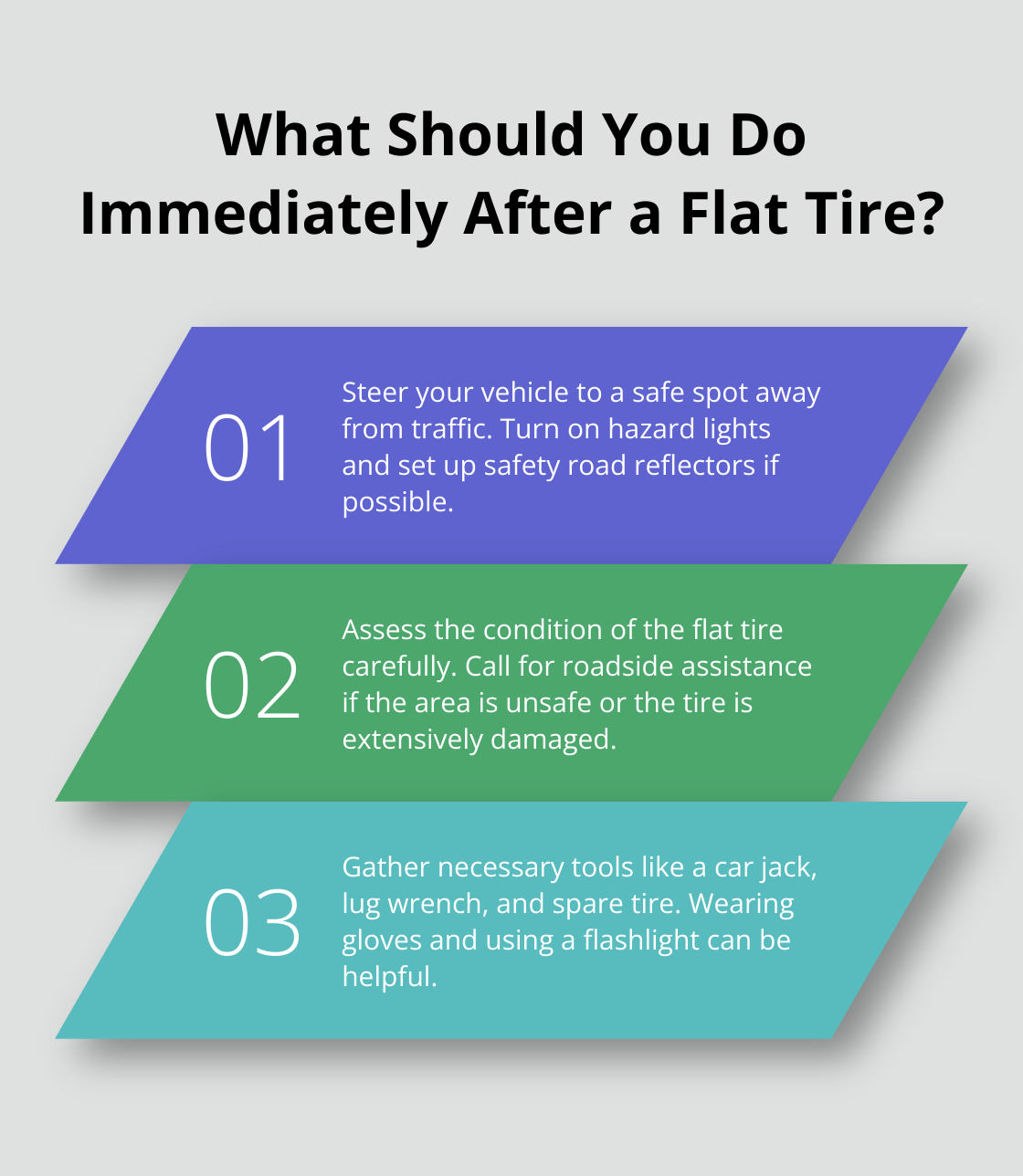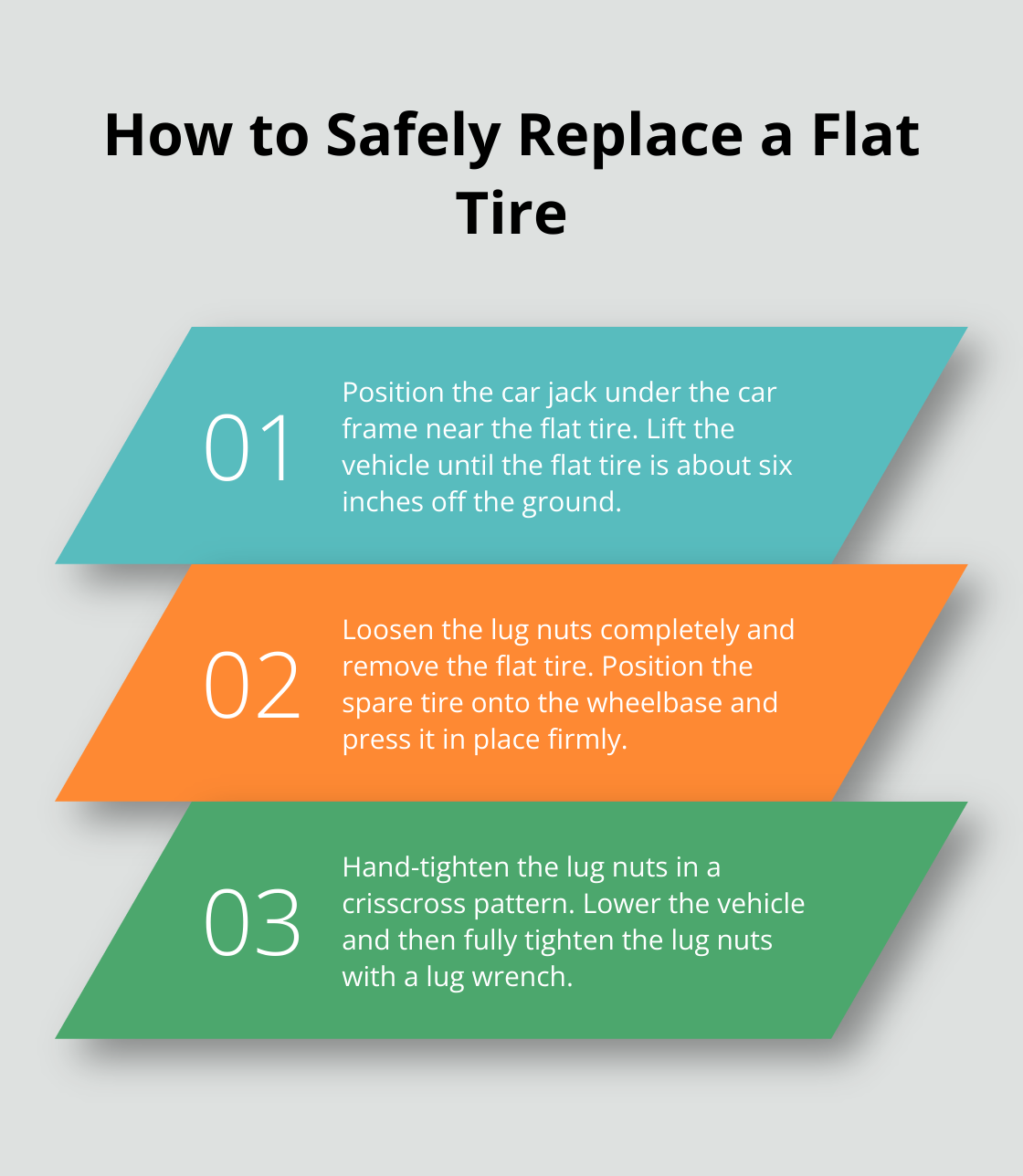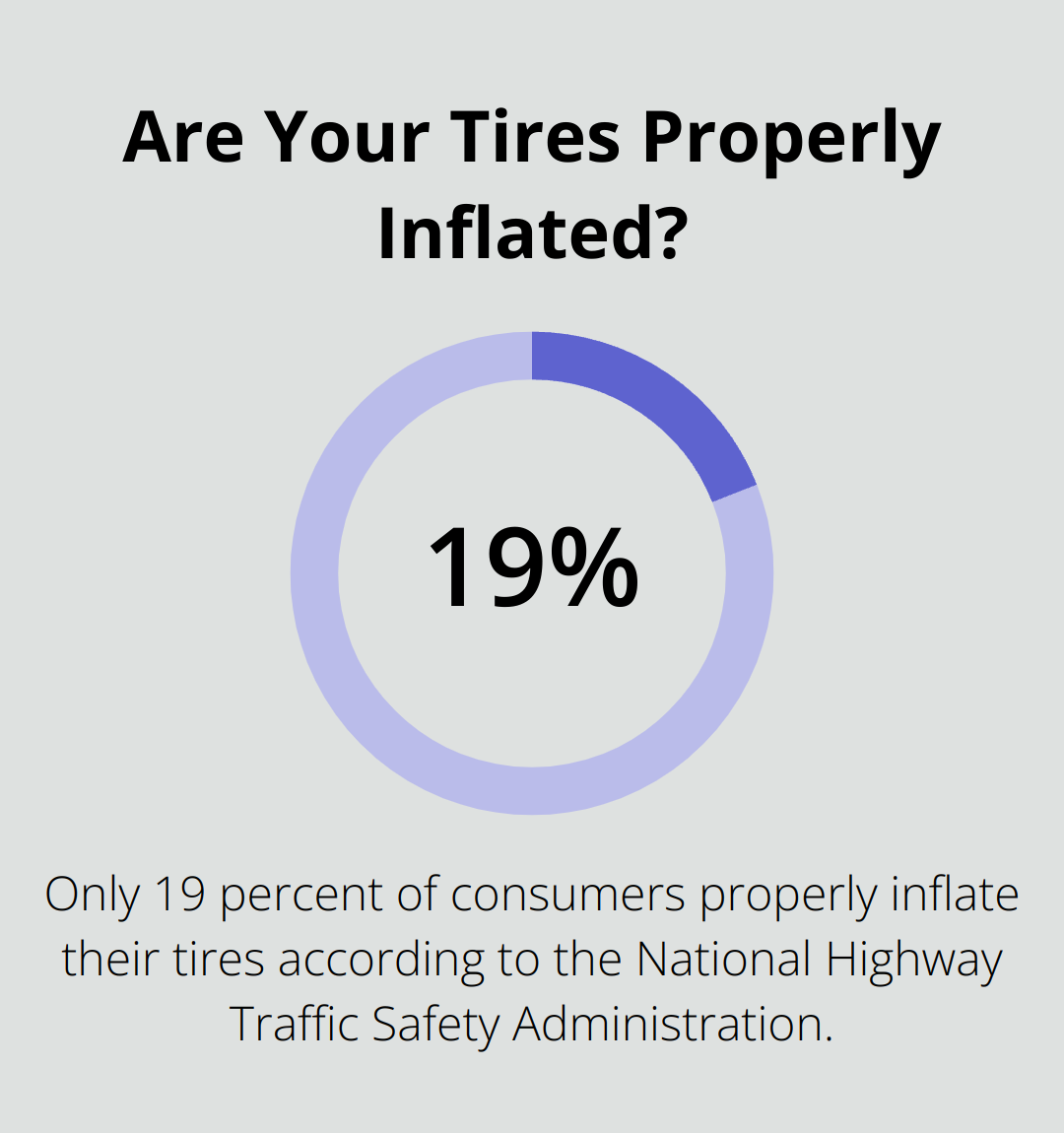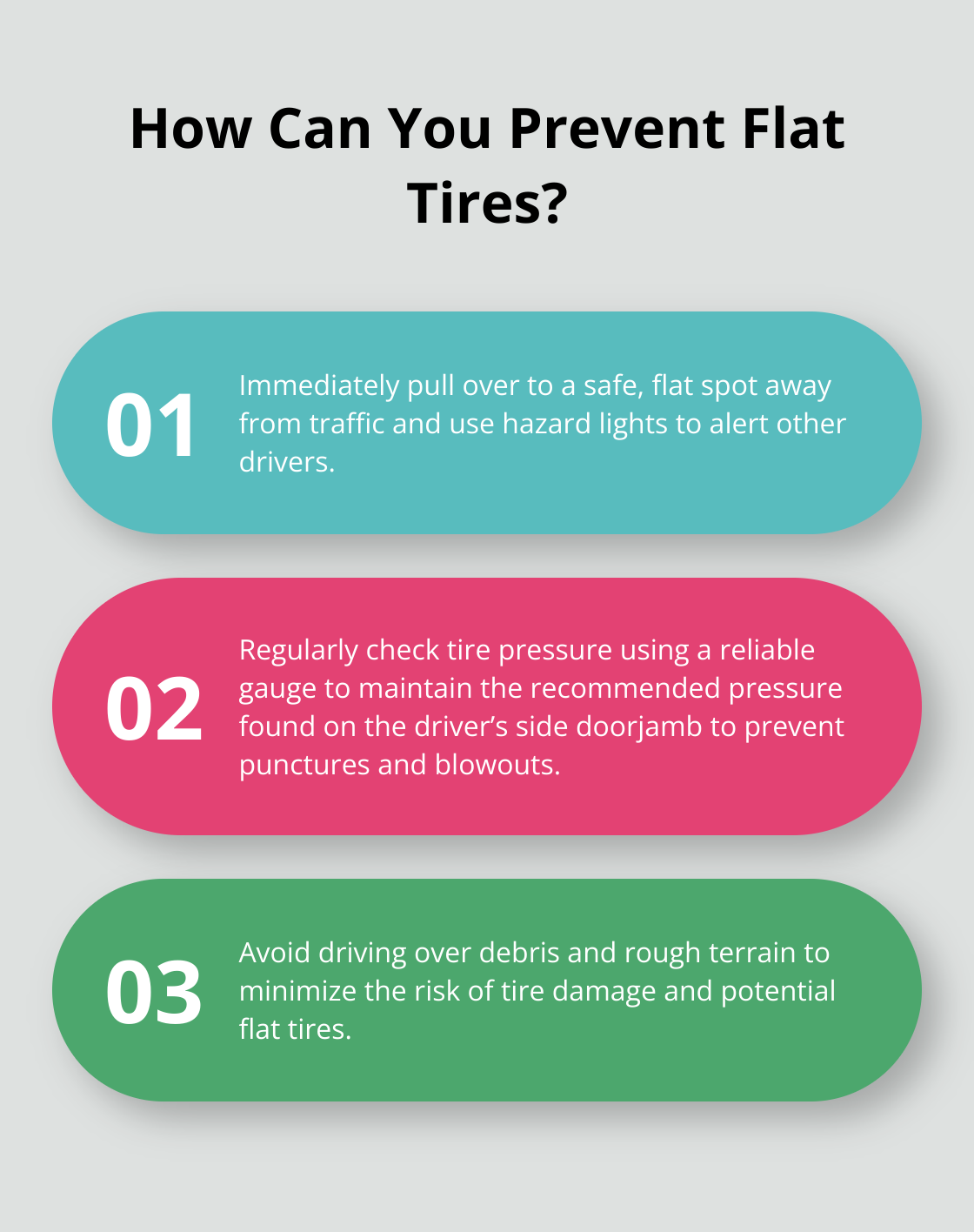Flat tires can be a major inconvenience, but knowing how to handle them can make all the difference.
At The Wiser Driver Driving School, we believe in empowering our drivers with practical skills to handle unexpected situations on the road.
This guide will walk you through the necessary steps to manage a flat tire efficiently and ways to prevent them in the future.
What Should You Do Immediately After a Flat Tire?
Encountering a flat tire can be nerve-wracking, but prompt and correct action is essential. Here’s how to handle the situation effectively:
Pull Over Safely and Use Hazard Lights
First, steer your vehicle to a safe spot, away from traffic. An ideal place is a flat area on the shoulder of the road or a parking lot, but avoid curves or hills. Turn on your hazard lights immediately to alert other drivers. If possible, set up safety road reflectors to further increase your visibility.
Assess the Situation
Once you are safely parked, get out of the vehicle carefully and assess the condition of the flat tire. Check for visible damages like punctures from nails or other debris. Also, identify if it’s safe to change the tire there. If the area feels unsafe or the tire is extensively damaged, consider calling for roadside assistance. Proper tire tread and pressure are essential for preventing flat tires in the first place.
Prepare Your Tools
Before you start the process, gather the necessary tools. You will need a car jack, a lug wrench, and of course, the spare tire. Also, wearing gloves can protect your hands, and having a flashlight can be helpful if it’s dark. Remember, about 42.2% of drivers feel confident changing a tire; having the right tools and knowledge can make a crucial difference.
By taking these initial steps, you can ensure safety and set the stage for a smoother tire-changing process.

How to Replace a Flat Tire
Use a Jack to Lift the Vehicle
Once you have your tools ready, position the car jack under the car frame near the flat tire. Your vehicle’s owner’s manual will indicate the correct spot for the jack. Placing the jack in the wrong location can cause damage or even result in the car falling. Gradually lift the vehicle until the flat tire is about six inches off the ground. This height ensures you have enough clearance to remove the tire and replace it with the spare.
Remove the Flat Tire and Install the Spare
With the car securely lifted, begin loosening the lug nuts completely. It’s advisable to use your lug wrench to remove them in the same order you loosened them earlier. Carefully take off the flat tire and set it aside. Now, position the spare tire onto the wheelbase, lining up the holes with the lug bolt threads. Press the spare tire in place as firmly as you can with your hands.
Properly Tighten the Lug Nuts and Lower the Vehicle
Once you’ve fitted the spare tire, start tightening the lug nuts by hand. It’s essential to use a crisscross pattern to ensure the tire seats evenly. Failure to follow this pattern can lead to an imbalanced placement, posing a safety risk. After hand-tightening, use the lug wrench to secure them further, but don’t apply full force yet.

Lower the vehicle slowly using the car jack until the spare tire touches the ground firmly. Now that it’s no longer suspended, tighten the lug nuts completely using the lug wrench. A torque wrench can help you to achieve the proper tightness, ensuring the nuts are neither too tight nor too loose. Properly inflated tires and well-tightened lug nuts are crucial as they maintain the vehicle’s balance and safety on the road.
How to Prevent Flat Tires
Regularly Check Tire Pressure
Maintaining the right tire pressure is vital for preventing flat tires. Tires with the correct air pressure ensure better grip and fuel efficiency. The National Highway Traffic Safety Administration reports that yet only 19 percent of consumers properly inflate their tires, which affects safety and fuel economy. To avoid this, check your tire pressure monthly using a reliable tire gauge. The recommended pressure can usually be found on the driver’s side doorjamb. Keeping your tires properly inflated reduces the risk of punctures and blowouts. For further tips, check out The Wiser Driver Driving School blog.
Inspect Tires for Wear and Tear
Regular tire inspections can help you spot early signs of wear and tear, reducing the likelihood of flats. Look for visible damages such as cuts, cracks, or bulges. Use the penny test to check tread depth: insert a penny into the tread with Lincoln’s head upside down. If you can see the top of Lincoln’s head, it’s time to replace the tire. Tires typically last 6-10 years, but frequent inspections every month can prevent unexpected flats and improve overall safety. Myers Automotive advises replacing worn tires promptly to avoid accidents.
Avoid Driving Over Debris and Rough Terrain
Debris and rough terrain pose significant risks to tire health. Construction sites and poorly maintained roads have higher chances of containing nails, glass, and other sharp objects. The U.S. experiences a tire puncture every seven seconds, translating to roughly 220 million flat tires annually. To minimize the risk, avoid driving in these areas when possible. If you must, drive cautiously, maintain a safe distance from the vehicle ahead, and keep an eye out for obstacles that could damage your tires. This proactive approach greatly reduces the chances of encountering a flat tire. For more advice on safe driving practices, visit The Wiser Driver Driving School blog.

Conclusion
Handling a flat tire effectively involves prompt and correct action, including safely pulling over, assessing the damage, and using the right tools to change the tire. Regular maintenance and preparedness can greatly reduce the risk of encountering flat tires. Checking tire pressure monthly and inspecting for wear and tear are essential practices that enhance safety and extend tire life. Additionally, avoiding driving over debris and rough terrain minimizes the chances of punctures.

Being prepared for a flat tire situation is crucial. Keeping a tire repair kit in your vehicle ensures you’re ready for emergencies, providing peace of mind and reducing potential stress on the road. We at The Wiser Driver Driving School emphasize the importance of these proactive measures, as they contribute to your overall safety and confidence as a driver.
Boost your driving confidence and learn more about safe driving practices through our comprehensive programs at The Wiser Driver Driving School. Our offerings include Joshua’s Law classes, personalized driving lessons, defensive driving courses for license points reduction, and road testing services available every day of the week. With the professionalism and expertise of our instructors, you’re in good hands, whether you’re a new driver or looking to refine your skills.



